Stock management is essential from the moment you start selling products whose quantity is depleting at each sale.
In order to assert if you need PrestaShop's advanced stock management feature, read this chapter's "General concepts": http://doc.prestashop.com/display/PS16/General+Concepts.
If you wish to use the advanced stock management, you must:
|
Stock management within PrestaShop runs through several screens, and can use one of two levels.
These levels are:
These screens are:
The following section describe these pages one by one.
In PrestaShop 1.4, you could manually set the quantity of product available for sale. In PrestaShop 1.5 and 1.6, you can still set the quantity manually for each product. But once advanced stock management is also enabled, you can also automatically set the quantity depending on the current quantity status of the physical product. Note that it is possible to enable advanced stock management globally, yet only use it for one product or just a few. |
When the "Enable stock management" option is enabled (in the "Preferences > Products" page), all the products get a new tab in their administration page, called "Quantities". This clear and simple interface enables you to manage the available quantities for sale on your shop(s) for a given product, and any potential combination.
With only this option enabled, you can manage the product quantities for individual products, one by one.
If you prefer to have all your product quantities managed directly from PrestaShop's advanced stock management feature rather than on a product basis, you have to enable another option from the "Preferences > Products" page: "Enable advanced stock management".
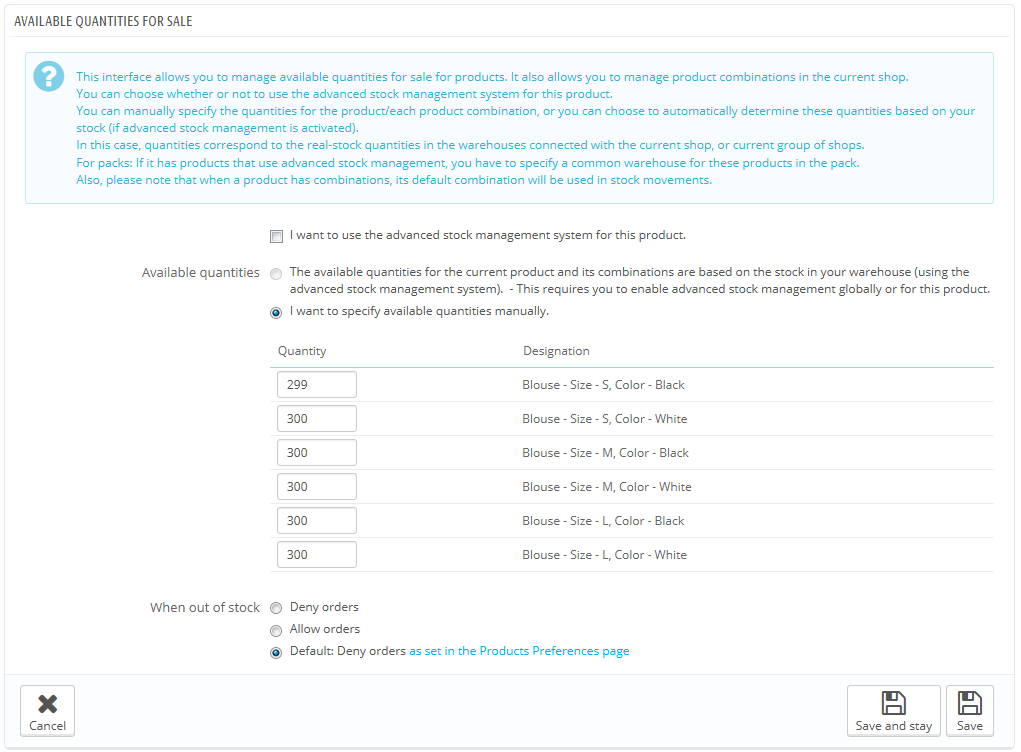
The "Quantity" tab opens with an explanatory section, which we urge you to fully read. That section is followed by the quantities management interface itself, which opens with three options:
By default, the third option is ("I want to specify available quantities manually") is enabled. As long as you haven't check the first option ("I want to use the advanced stock management system for this product"), quantities are managed the same way they were in version 1.4 of PrestaShop, which means that you have add the quantities manually, and PrestaShop will remove quantities for each sale.
If you'd rather synchronize the available quantities with your warehouse stock (or that of several warehouses), you have to change the quantities management method:
As soon as you have selected the second option, the table's "Quantity" column cannot be edited anymore: quantities are now directly handled from the advanced stock management feature rather than from each product's "Quantities" tab.
Product packs are a special case. Since it is not yet possible to add product combinations to a pack, the PrestaShop developers have decided that when necessary, PrestaShop would use the default combination when decrementing the physical stock. Also, a notice indicates the recommended maximal number of packs. |
The rest of the tab explained in the "Managing the Catalog" chapter of this guide.
You can now set more than one supplier for a given product. For each supplier associated to a product, you can set the supplier's reference number and a default purchase price for that product as well as its combination. This information is used when making an order to the supplier.

If advanced stock management is enabled, a "Warehouses" tab appears in the product sheet, where you can indicate which warehouse(s) the product and each of its combinations can be stored in. You can even indicate the location for the product and its combinations.
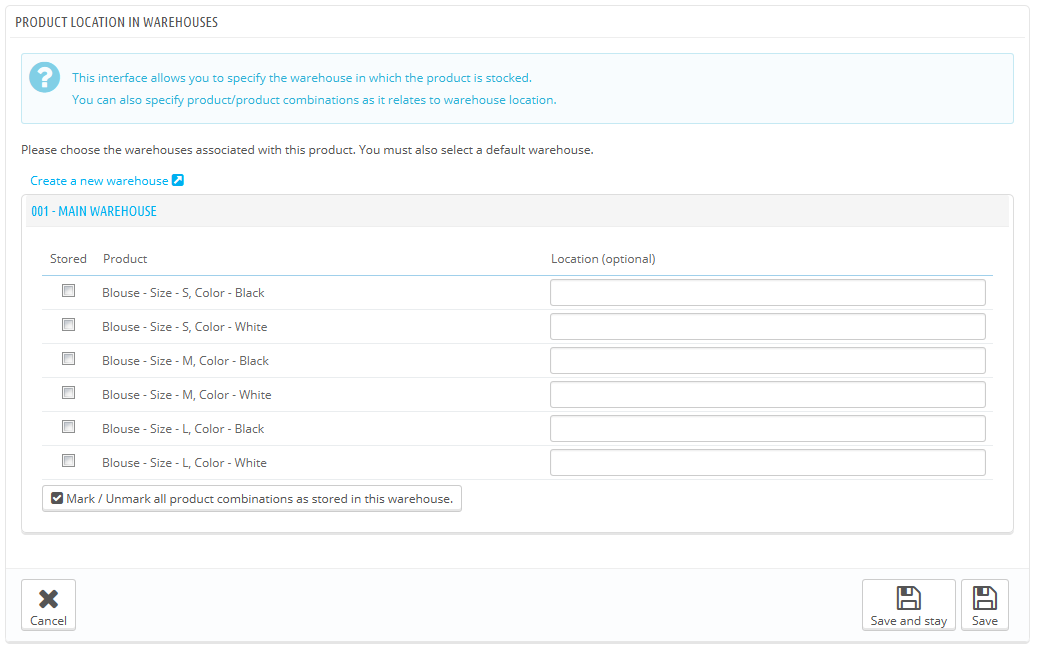
You must first create at least one warehouse (see below) before associating a product to it and setting the product location in it. This step is essential: it is important to at least set one warehouse in which a product can be stored. This will have considerable impact on the order preparation in the multi-shipping context.
The advanced stock management feature makes it possible to create one or more warehouses. In order to create one, go to the "Warehouse" page under the "Stock" menu.

Once you start creating a new warehouse, you must fill in the following fields:
It is not possible to change a warehouse's valuation method and currency once it has been set. If you need to change that information, you will have to recreate the warehouse, and delete the wrong one. You can only delete a warehouse if it does not contain any product anymore. |
Be careful of the carriers you choose to authorize, as this will a huge impact on the order preparation in the multishipping scenario.
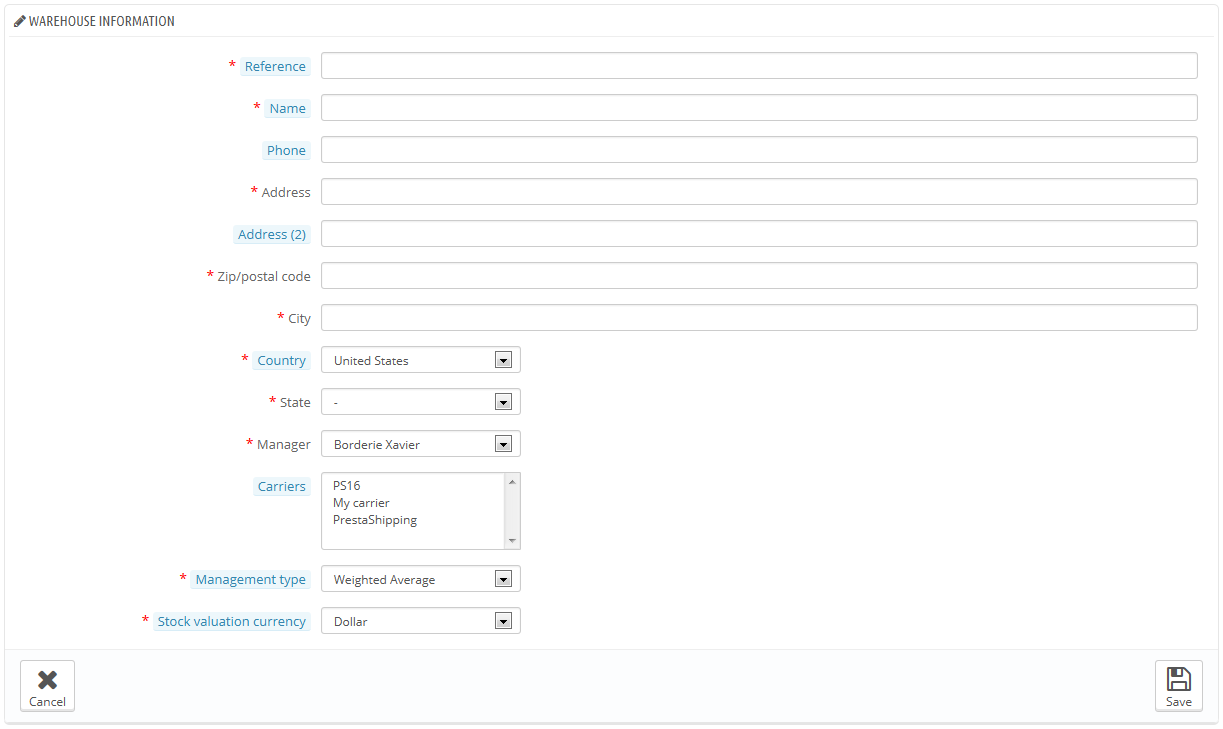
In the situation where you manage more than one shop, you will also have to associate each shop to one or more warehouses. This enables you to set from which warehouse the client orders for a given shop can be sent.
Once the warehouse has been created, you are taken back to the list of warehouses. Click the "View" icon on the right of its row to access a bird's eye view of its information, including the references of all the products stored in it, the sum of all the available quantities, a global accounting valuation, details of the stored products, and the history of the stock movements for that warehouse.
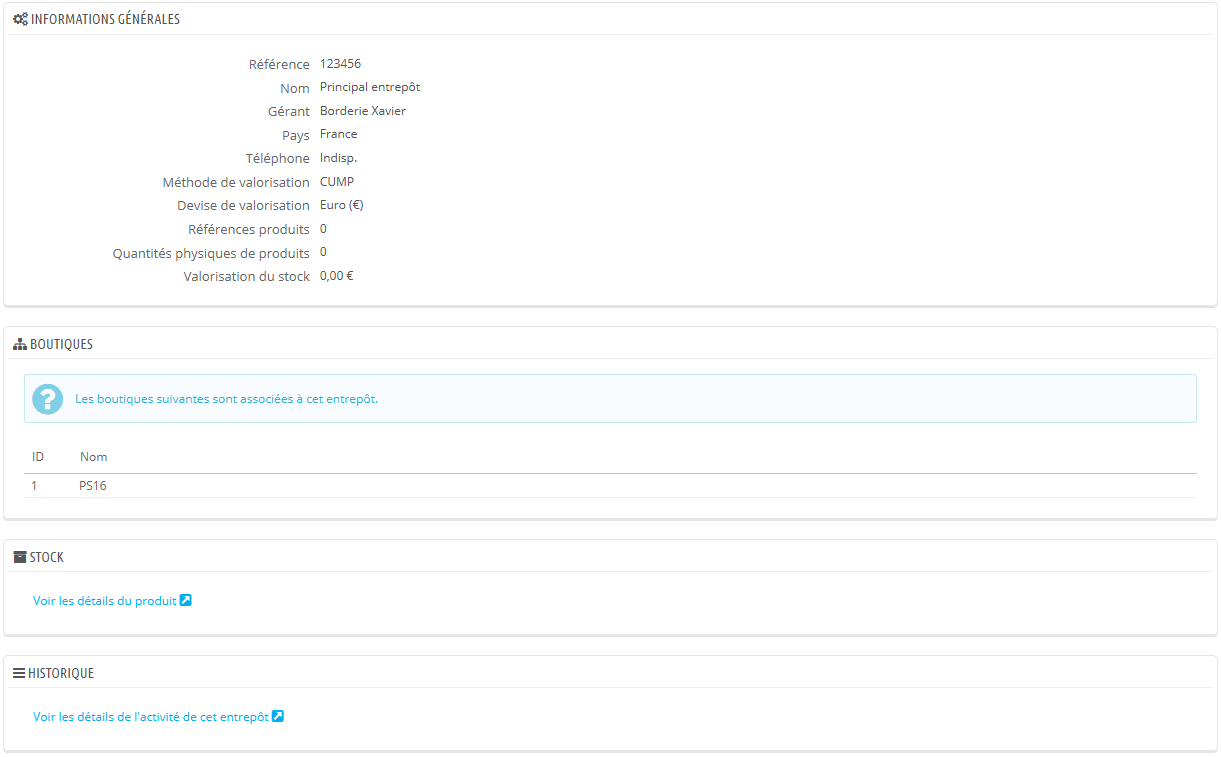
Each warehouse page also contains two links at the bottom:
Now that you have created one or more warehouses, you have to set stock for each of them. To that end, go to the "Stock Management" page under the "Stock" menu.

All available products from your catalog are listed in this interface. If you have any combination of product, you can manage them from the "Details" action.
In your daily activities, you can use this interface in order to manually:

The last two actions only appear if there already is some stock of the chosen product in any warehouse.
The "Transfer stock" only appears if you have at least two registered warehouses.
To add more stock to a product, use the "Add stock" action (up arrow) for said product or product combination. A new page opens, containing a form where the most important information is displayed in order to help you identify a product with certainty (reference, EAN13 and UPC code, and name). This information cannot be changed from this form, therefore it is grayed out.

You must then set:
When hovering the "Quantity to add" and "Unit price (tax excl.)" fields with the mouse cursor, the interface will display a reminder of their values the last time you added some stock. |
When you want to remove a certain quantity of product stock, you must use the "Remove stock" action (down arrow, available only when there already are products in stock). A new page opens, containing a form where the most important information is displayed in order to help you identify a product with certainty (reference, EAN13 and UPC code, and name). This information cannot be changed from this form, therefore it is grayed out.
You must then set:
The stock transfer enables you to transfer stock from one warehouse to another, or from one status to another (usable in store / reserved) within a single warehouse. Click on the "Transfer stock" action (sideways arrows, available only when there already are products in stock). A new page opens, containing a form where the most important information is displayed in order to help you identify a product with certainty (reference, EAN13 and UPC code, and name). This information cannot be changed from this form, therefore it is grayed out.
You must then set:
For these operations, all that is related to valuations is run automatically according to the management method chosen for each warehouse. Currency conversions work the same.
This interface enables you to view the stock movement history. You can display all of the stock movements, or only those tied to one warehouse. Filters can be applied to refine your search.

When the "Filter movements by warehouse" drop-down list is set to a warehouse, you can make a CSV export of the obtained list.
This interface enables you to have an instant overview of your stock, either globally or per warehouse. The numbers are current.

For each product or product combination in stock, the following indicators are available:
As appropriate, and depending on the chosen valuation method, the breakdown of the unit prices and of the associated valuations is available by clicking on the "Details" action.
Moreover, for a given warehouse, you have two ways to export the current list in CSV format:
This interface enables you to overview the coverage of your stock. The coverage indicates how many days your current stock can last. This information is very useful, as it helps you predict the necessary restocking. Coverage is calculated according to previously registered stock movements.

You can get the stock coverage for all the warehouses, or for a single warehouse.
You can also set the time period (one week, two weeks, three weeks, one month, six months, a year) of registered stock movement which is to be taken into account when calculating the coverage.
Finally, you can highlight the stock coverage which is below a given number of days. This will highlight the relevant products, helping you identify them quicker.
In order to view the stock coverage of product combinations, you have to click the "Details" action of the product.
It is possible to receive notifications of the stock coverage for a product. The e-mail notification module (mail alerts) can take product stock coverage into account. It is thus possible to set a number of coverage days below which you will receive a notification. See the configuration for this module. |
One of the major features of the stock manager is the ability to place orders to suppliers so as to better manage your restocking.
This interface enables you to manage all your supplier orders, as well as reusable order templates.

The order template creation process is the same as the order creation process (except for the "Expected delivery date" field). We will therefore only explain the order creation process.
The creation of an order for a supplier can be broken down in two steps: creating the order, then adding products to it.

So, the first step is to define the order's headers:
The second step consists of adding actual products to the order. To make that second step, you can either:
The interface of the order creation form has been updated with a second form below the previously-filled fields. You must use that second form to add products to your order, using the integrated search engine. The products that you add appear in a new list.

For each product, you must set or update the unit purchase price (tax excluded), the quantity to order, any applicable tax rate, and any product-specific discount.
Once the order is created, it appears in the list with the "Creation in progress" status. This status enables you to view and edit the information that were previously entered as well as add products to the order. You will not be able to change the order once you change its status to "Order validated".
You can never delete a supply order: you can only cancel it. |
You need to follow through for the whole order process, always indicating its status change in PrestaShop's interface. This is what the first action button of the list ("Change state") is for: click on it to reach the status changing form. See the "Changing the status of a supplier order" section below for more information on the available statuses, and see the "Registering the reception of products" to understand how to follow through on a supply order.
The "+" icon in the supply order list displays the order's history, which enables you to see who did what and when.
The whole point of creating a template is to serve as a basis for new orders.

The supply order template creation process is the same as the one for a real order, except that:
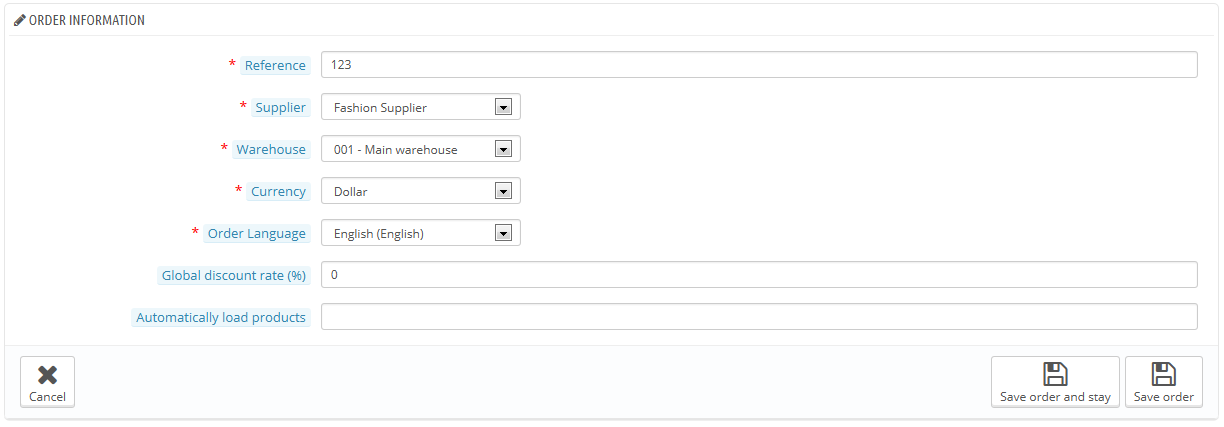
Moreover, contrary to an ordinary supply order:
Once you have created your template, you only need to use the "Use this template to create a supply order" action from the template list (the "two windows" icon) to start creating an order.
Each order has many available actions (in the "Actions" column of the order list). One of them enables you to edit the status: the "Change state" one. There are six possible default statuses, but you can add your own (see the "Configuration" section of this chapter).

An order's status helps you understand your stock movements at a glance thanks to their color code. Here is the significance of the six default statuses:
With each status change, the status drop-down selector evolves in order to present only the possible status changes, in regard to the current status. The unavailable statuses are grayed out.
Clicking the "View" icon from the list of supply orders enables you to get a synthetic view of your order.
You can also download the invoice generated as a PDF file (provided the order is validated by you) from the list of orders or from the status change page.
The "Details" action enables you to display the status change history for the current order.
You must change the status of your supply order within PrestaShop as soon as actions are taken in the real world. This is done using the "Change state" action in the "Actions" column from the list of orders. The form in this page always preselects the next logical status, but you are free to choose any of the other statuses available.
While you are preparing the supply order, keep its status to "Creation in progress". Once you are done preparing the order, switch it to "Order validated", then print the invoice PDF and send it to your supplier. As soon as your supplier confirms the reception of the invoice, change the status to "Pending receipt".
During the "Pending receipt" and "Order received in part" statuses, a new action is available in the "Actions" column. Using the "truck" icon, the "Update ongoing receipt of products" action enables you to register the reception of products for a given order during the current day.
The form that opens after clicking that "truck" action enables you to see how many items were expected, and to indicate the quantity of product delivered for each product that day. Click the "Update selected" button to mark the selected products as received with the number of items you indicated in the "Quantity received today?" field. The checkbox on the left of each row must be checked for PrestaShop to take that line into account.
This step can be done as many times as necessary, and it is possible to receive and incorporate more stock than planned. If you receive less stock than expected, PrestaShop automatically changes the order's status to "Order received in part". |
For each product, a reception history is available ("+" action), as well as an indication of the received quantity, the expected quantity, and the remaining quantity. If the "received quantity" is equal to the "expected quantity", the corresponding row is highlighted in green. If you received more than expected, it is in red.
When all the products from the order have been received, you must manually change the supply order's status to "Order received completely". This ends the supply order process, and a new "Export" action appears, which you can use to download a CSV file of all the information pertaining to that order.
Using the supply orders interface, you can filter the list of orders or the details of these orders so that you may export it, according to the current filters (reference, supplier, etc.).
Moreover, you can choose not to display the orders that are completed or canceled, using the appropriate checkbox.
The configuration page enables you to customize the way certain parts of the advanced stock manager work:
You can add custom statuses corresponding to your business line. You cannot delete a default status.
The list on the main page enables you to get a better perspective of the available statuses, and how they can impact an order.
Click the "Add new" button to reach the creation form.
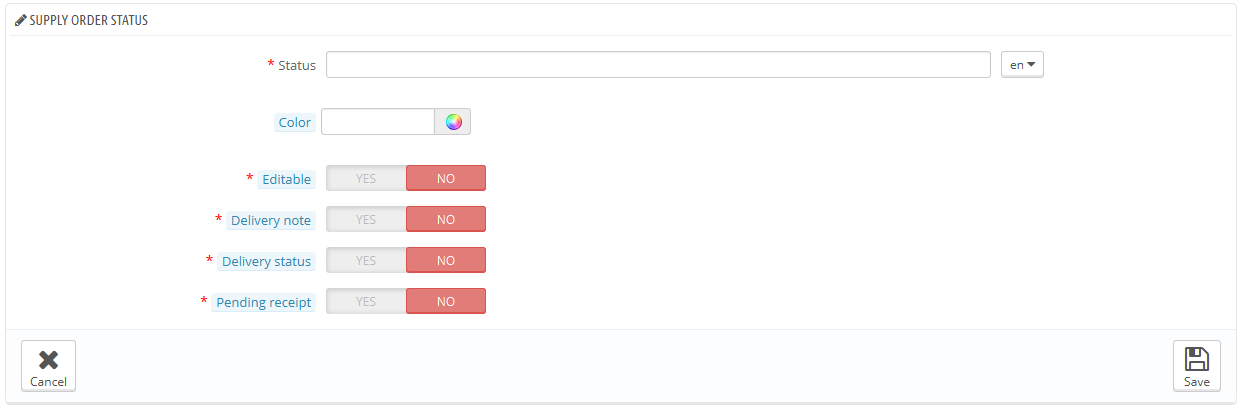
A status has a label, a color, and enables you to define whether:
It is possible to add more labels to stock movements. Click the "Add new" button from the "Stock movement labels" section to access the creation form.

You simply have to set a name for the label, and indicate whether it pertains to stock increase or decrease. Those labels can be used when adding/removing/transferring stock manually (as explained earlier).
It is possible to choose the default stock movement labels in the following standard cases:
